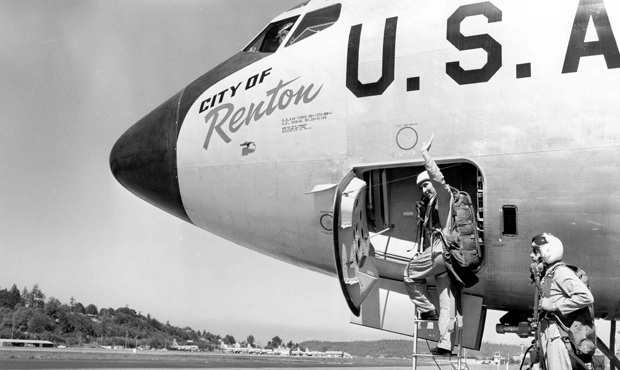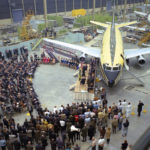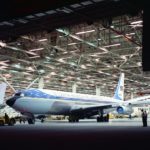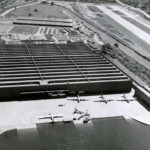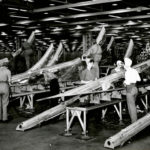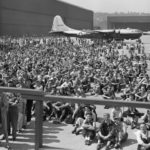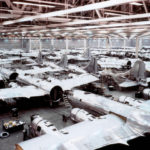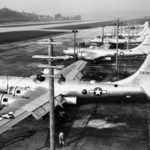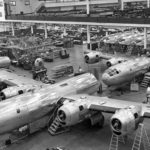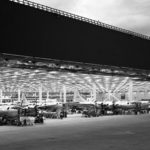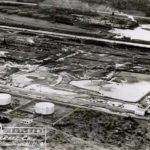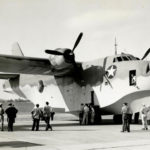Boeing’s aviation history in Renton: From World War II to the 737 Max
Jan 25, 2024, 9:30 AM | Updated: 2:34 pm
Editors’ note: This story originally was published Sept. 25, 2019.
Boeing’s Renton plant has seen a lot of aviation history come and go in its nearly 80 years of operation. Long before the recent grounding of the Renton-built 737 Max, the factory may have set a record for the number of iconic aircraft manufactured there.
“I haven’t sat down and done the math, but I’m fairly certain that Renton leads the world in producing big airplanes,” said Boeing archivist Mike Lombardi in his office. “We figure there was a thousand B-29s, close to a thousand KC-97s, 700-plus KC-135s and then 1,010 707s, [and] over 1,800 727s.”
But the numbers don’t end there.
“The 737 is over 10,000,” Lombardi said. “The 757 was built there, and that was another 1,000-plus airplanes, I think 1,050.”
Other Boeing locations might come to mind before Renton does, Lombardi says, because of the B-17 Flying Fortresses built at the old Plant 2 along East Marginal Way South, or the Everett factory where 747s and 767s were once mass produced. That’s also where 777 and 787s are now assembled.
“Renton has just been an incredibly productive site and quietly just created all this wonderful history, and the ongoing legacy of commercial aviation,” Lombardi said.
“It really is there in Renton,” he added.
Lombardi, whose office at the Boeing Archives is an aviation geek’s dream — filled with scale models, photos, plans and all kinds of other goodies related to every aspect of Boeing’s history — explained the history of the Renton plant and some of the aircraft that were manufactured there.
Sea Ranger is Boeing’s first Renton aircraft
Mike Lombardi says it all began for Boeing at Renton before there was even an airfield there, when there was still just a simple seaplane base. In the late 1930s and early 1940s before the US entered World War II, the U.S. Navy was looking ahead to possible battles in the Pacific.
One tool the Navy thought it needed was the PBB-1 “Sea Ranger.”
“The strategy at the time for the United States Navy for fighting a war in the Pacific would be to use these big flying boats … to fly long distances across the Pacific to fight the war in that manner [in a place where] there probably wouldn’t be airfields. So a flying boat would be the way to go. So that was the strategy.”
The Navy hired Boeing to start mass producing Sea Rangers.
“They needed a site to do it. So Renton was selected,” Lombardi said. And so, ground was broken in September 1941 in a marshy spot at the south end of Lake Washington. “They built the plant, built [seaplane] ramps into Lake Washington. There wasn’t an airfield. [They] didn’t need one. These were floatplanes.”
But after Pearl Harbor, the Navy’s outlook for the war ahead began to shift.
“The strategy for the Navy started to change, and especially at the time of the Battle of Midway, just seven months six months after the war [began for the US] and no longer was the strategy of building big seaplanes viable,” Lombardi said. “So they canceled the contract, and that was it.”
The B-29 Superfortress
Like the Navy, the Army Air Force was also looking at its projected wartime needs, and at how Boeing might help, Lombardi says.
“Another important program that Boeing was working on at Seattle was, in fact, the most important wartime program in the United States, even more so than the Manhattan Project to make the atom bomb,” Lombardi said. “And that was to build a ‘super bomber.’”
“The atom bomb wasn’t going to go anywhere without an airplane to carry it,” Lombardi continued. “In the United States, our number-one wartime strategy was using air power. So this was the most important program in in the war effort, and because of that, Boeing here in Seattle and the Renton plant [one of three locations where the B-29 bomber would be built] became one of the most important factories in wartime America.”
Lombardi says legend has it that the Army Air Force secured the Renton plant from the U.S. Navy by trading 700 B-25 bombers in exchange for taking over the gently-used factory.
By whatever horse-trading, Renton became home to the B-29, as the Boeing workers there quickly showed their mettle once manufacturing got underway in late 1943.
“In January 1944, they deliver two airplanes,” Lombardi said. “By July of the following year, 1945 – what, 18 months later? – the rate was up to a 160 airplanes a month. They were building five planes a day.”
At its peak, there were 7,200 workers at Renton, including 3,300 women, or so-called “Rosie the Riveters.”
And to achieve those production numbers didn’t require working around the clock, Lombardi pointed out.
“They weren’t working 24 hours a day,” Lombardi said. “There was two shifts [of manufacturing] and … a third shift, but that was mostly just to realign things in the factory and do some cleanup, but the production was two shifts.”
Boeing and PACCAR’s wartime impact on Renton
Elizabeth Stewart is director of the Renton History Museum. She says that Boeing and Pacific Car & Foundry (later known as PACCAR) both attracted huge workforces to Renton during World War II, and each company also attracted smaller companies in their respective supply chains. Pacific Car, which had previously built trucks and railroad cars, had an Army contract to build Sherman tanks.
The impact on Renton from all those defense workers, Elizabeth Stewart says, was huge.
“Ultimately, the population more than tripled,” Stewart wrote in an email. “In 1941, Renton’s population was 4,488 and by 1945 it was 16,039. The school-aged population doubled during the war; some schools went to double, or even triple shifts, and added portable classrooms to their campuses.”
All those war workers – and their families – needed places to live.
“City government asked people to open their homes to strangers, and later stopped giving permits for any construction except housing,” Stewart wrote.
Stewart says that like similar publicly-funded developments in a lot of communities during World War II, the defense worker housing that would become Renton Highlands was controversial.
“I haven’t seen the numbers anywhere, but the sense among Rentonites was that the Renton Highlands would overwhelm the existing town, and there was a fair amount of hostility, according to some of the oral histories we have,” Stewart wrote.
“The Highlands ultimately covered 420 acres with 2,420 units of different kinds (single family, duplexes, and apartments for single men and women); 1,500 of these were meant to be ‘demountables’ that would be torn down after the war, but the population did not shrink after the war as expected,” Stewart wrote.
After World War II, Boeing leaves … and elephants arrive
World War II ended officially in September 1945. Boeing kept building B-29s at Renton until May 1946 and then, just like that, the company pulled up stakes.
At this point, Mike Lombardi says, “The site still belongs to the government … it’s used for storage as, at the time, Sand Point [now Magnuson Park] is still an active Navy base, so they used the Renton plant to store airplanes.”
“It’s crowded with all these different seaplanes, Martin PBMs and Consolidated PBYs are all stacked up in there,” Lombardi added. And then, in the winter of 1946-1947, “the Sparks Circus comes to town, and they need a place to store all of their train cars and supplies and their elephants. So there’s these wonderful pictures of elephants wandering around in the Renton plant.”
Boeing returns to Renton for the catalytic KC-97
Aviation was changing rapidly in the years after World War II, and Boeing was part of one of the most significant shifts, with invention of the “flying boom” for more safely refueling military aircraft in midflight.
“Before [the flying boom], the idea had started back in the 1920s of hanging a hose over the side of an airplane, and then pouring a can of gas into the hose to refuel another plane. And so that kind of carried through World War II, this idea of using hoses,” Lombardi said.
“But Boeing comes up with this idea of using a boom, where they can transfer fuel quickly and safely. You don’t have to have somebody hanging out an airplane trying to catch the hose.”
So, after just a few years’ absence from Renton, Boeing gets an Air Force contract to convert B-29s into airborne refueling tankers, and the company returns to the southern end of Lake Washington to get the work done.
“Then, Boeing starts a production line to build the world’s first dedicated tanker airplane,” Lombardi said. “And that’s the KC-97, and that production line is at Renton, and the first flight [was in] 1949.”
Dash 80, KC-135 and 707
Mike Lombardi said that the Renton-built KC-97 was the unlikely catalyst that ultimately transformed the World War II-era Boeing into the jet-powered company of the future.
How did the propeller-driven KC-97 play this future-creating role? With a little help from Boeing’s jet-powered B-52 bomber, naturally.
“The KC-97 has to go into a dive to get up enough speed to keep up with the jet-powered B-52,” Lombardi said, describing what the relatively slow propeller-driven tanker had to do to meet up with the speedy bomber. “Meanwhile, the B-52 drops its flaps, drops its landing gear, ‘dirties up’ as much as it can to slow down to try to not overrun the KC-97.”
In this difficult maneuver, Lombardi says, Boeing sees an opportunity.
“’Let’s turn that KC-97 into a jet,’” is what Lombardi says the engineers said.
“And so that’s really the beginning of what became the ‘Dash 80,’” – or, the prototype for the Boeing 707 jetliner – “because ‘Dash 80’ [is short for] ‘367-80,’” Lombardi said. “The KC-97 was the model 367,” and “367-80” (pronounced ‘367 dash 80’) was the official name of what became the basis for the company’s first civilian jetliner.
The Dash 80 rolled out at Renton in May 1954. The Air Force quickly ordered several of the tanker version, known as the KC-135. Soon after, airlines came calling for the civilian jetliner version, which became known as the 707, and which, it’s hard to overstate, revolutionized commercial air travel, establishing Boeing as a dominant economic force in the Pacific Northwest and the world.
A total of more than 700 of the military KC-135 and more than 1,000 of the civilian 707 were all built at, you guessed it, Boeing’s Renton plant.
Boeing 727
The 707 was just the beginning of what became a family of jetliners that were designed and built to serve different markets.
“In the early 60s, right after the 707 started to become very popular, Boeing saw that there would be a need for a ‘family’ of airplanes,” Lombardi said. “The 707 could serve some of the major airports, but it needed a lot of runway to take off and land, so there were smaller airports in big cities that it couldn’t serve.”
“LaGuardia [in New York] was the model or was the acid test” for a new model of Boeing jet. The airlines said, “‘We need a jet that can fly in and out of there,’” Lombardi described. “So Boeing worked on the next airplane that would fulfill that role, and that was the 727. It was designed to fly in and out of those small airfields.”
The 727 rolled out at the Renton plant on November 27, 1962; a total of 1,800 would ultimately be built there.
Boeing 737
The first Boeing 737 was “christened” on January 17, 1967 at a Boeing facility called the “Thompson site,” south of Plant 2 along East Marginal Way South.
The Thompson site “is that big gray building just north of that that Boeing building where today we build the Navy P-8 737s,” said Lombardi. “That building was originally made for the 737 program, and the first 271 were built there.”
But, just a few years later, as a result of the late 1960s economic downturn known as the Boeing Bust, the company consolidated production of all of its “single aisle” planes – 707s, 727s, and 737s – at Renton.
The Renton plant had been expanded in the mid 1960s in anticipation of building the Boeing Supersonic Transport (or ‘SST’) there; that program’s cancellation was what led to the Boeing Bust.
The 737, and its multiple variants, including the 737 Max, have been built almost continuously at Renton for nearly 50 years.
Boeing 757
The single-aisle Boeing 757 debuted at Renton on January 13, 1982; more than 1,000 of the jets would ultimately be built there before the model was retired from production.
Measuring Boeing’s social and cultural impact
Beyond the numbers of aircraft built by Boeing at Renton, the numbers of people employed there, and the total dollars pumped into the local economy, doing the math to measure the social and cultural impact of the company on the Puget Sound region doesn’t really give a satisfying result. In some ways, local history – particularly from the 1930s onward – is difficult to separate from Boeing history, and vice versa.
And, in spite of the troubles with the still-grounded 737 Max and the unfortunate deaths in the two 737 Max crashes, it’s a safe bet that Boeing isn’t done making aviation history at the old Renton plant.
You don’t have to do any math to understand that.
You can hear Feliks every Wednesday and Friday morning on Seattle’s Morning News with Dave Ross and Colleen O’Brien, read more from him here, and subscribe to The Resident Historian Podcast here. If you have a story idea, please email Feliks here.

